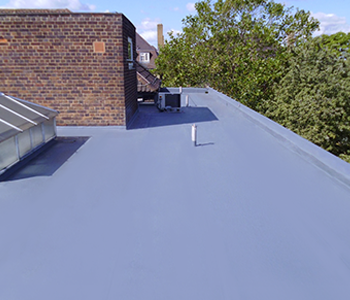With the government’s autumns statement (2022) announcing an additional £6.6bn to drive energy efficiency improvements, it is inevitable that a fabric first approach is at the forefront of specifiers' minds to help meet the ambition to reduce the UK’s energy consumption by 15% by 2030.
The decarbonisation agenda coupled with the energy efficiency taskforce objective to “increase the wider availability of materials required to deliver high quality upgrades at pace”, means that retrofitting projects that offer reduced wastage and reuse of existing materials whilst increasing energy efficiency are appealing.
Refurbishment with innovative overlay solutions to meet energy efficiency goals
For those buildings with flat roofs, there are many different waterproofing membranes found, ranging from asphalt and bitumen membranes to single ply and liquid systems. Whilst it may be easy to strip up and replace the roof build up above the deck, there is another way. Modern warm roof systems such as those which overlay existing waterproofing membranes can also incorporate thermal upgrades to the latest building standards to meet a fabric first objective.
In the commercial sector, the scope for minimum energy efficiency standards has been published. By 2030 the requirement for minimum energy performance certificate for commercial properties will be rating B, provided the required investment is cost effective. Rented commercial properties owned by both the private sector and council owned commercial buildings are included. Flat roof overlay solutions that incorporate thermal improvements could help meet that cost effective energy efficiency.
With cold liquid applied membranes as part of such warm roof build ups, there are other project benefits. With no hot works or associated risks, as well as rapid installations thanks to advanced resin chemistries, programs of works can be shorter than in the past. Such an approach not only offers a more sustainable project profile but means minimal disruption to building occupants too.
What should specifiers look for?
Specifiers may need assistance from specialist waterproofing manufacturers to assess options for any such flat roof refurbishment, but what should specifiers look for from providers to ensure project needs are met?
- Consultation: Look for a waterproofing manufacturer that will work with you to understand the project objectives for energy saving, budget and sustainability goals of the flat roof project.
- Understand the current state of the flat roofed building: any prelude to options needs to start with a thorough flat roof condition survey. Experienced providers such as Triflex include core sampling to ascertain the underlying roof build up condition. The impact of adding additional insulation with upstand heights, access points and outlets should always be considered.
- Testing: using liquid waterproofing membrane systems to overlay existing waterproofing membranes can significantly reduce wastage. Innovative solutions that involve reusing part of the existing build up as an air and vapour control layer in a thermally improved new build up need careful consideration. Of course, such a system must be fully bonded, with compatibility and relevant testing as part of an assessment of suitability. Look for a manufacturer with a proven track record of substrate testing.
- Bespoke project specification proposal: Be wary of generic information. To ensure the project objectives are met look for a manufacturer that provides a bespoke project specification that meets the objectives with wind uplift calculations, project specific U-values and condensation risk analysis. Specifications that incorporate clearly defined product consumptions can minimise material wastage and help provide budget security.
- Authorised contractors: who are fully supported by the manufacturer. From problem solving to quality installations, high standards are consistently met when manufacturers work closely with their authorised contractors. Training, on-site support and quality control are all services to look out for. In addition, membership of the Liquid Roofing Waterproofing Association (LRWA) and the National Federation of Roofing Contractors (NFRC) offers reassurance of quality products and services supported by codes of practice.
- Warranty: it’s important to look behind the warranty offered for applicability and reassurance. With manufacturers offering decades long warranties, the financial security of a company is increasingly important to be able to honour those warranties in the future.
Whatever the type of flat roof, with refurbishment projects on the increase, specialist waterproofing expertise such as those provided by Triflex is available to support specifiers with a range of services.
To take advantage of Triflex free suite of services to help you to deliver your project goals, get in touch here.

